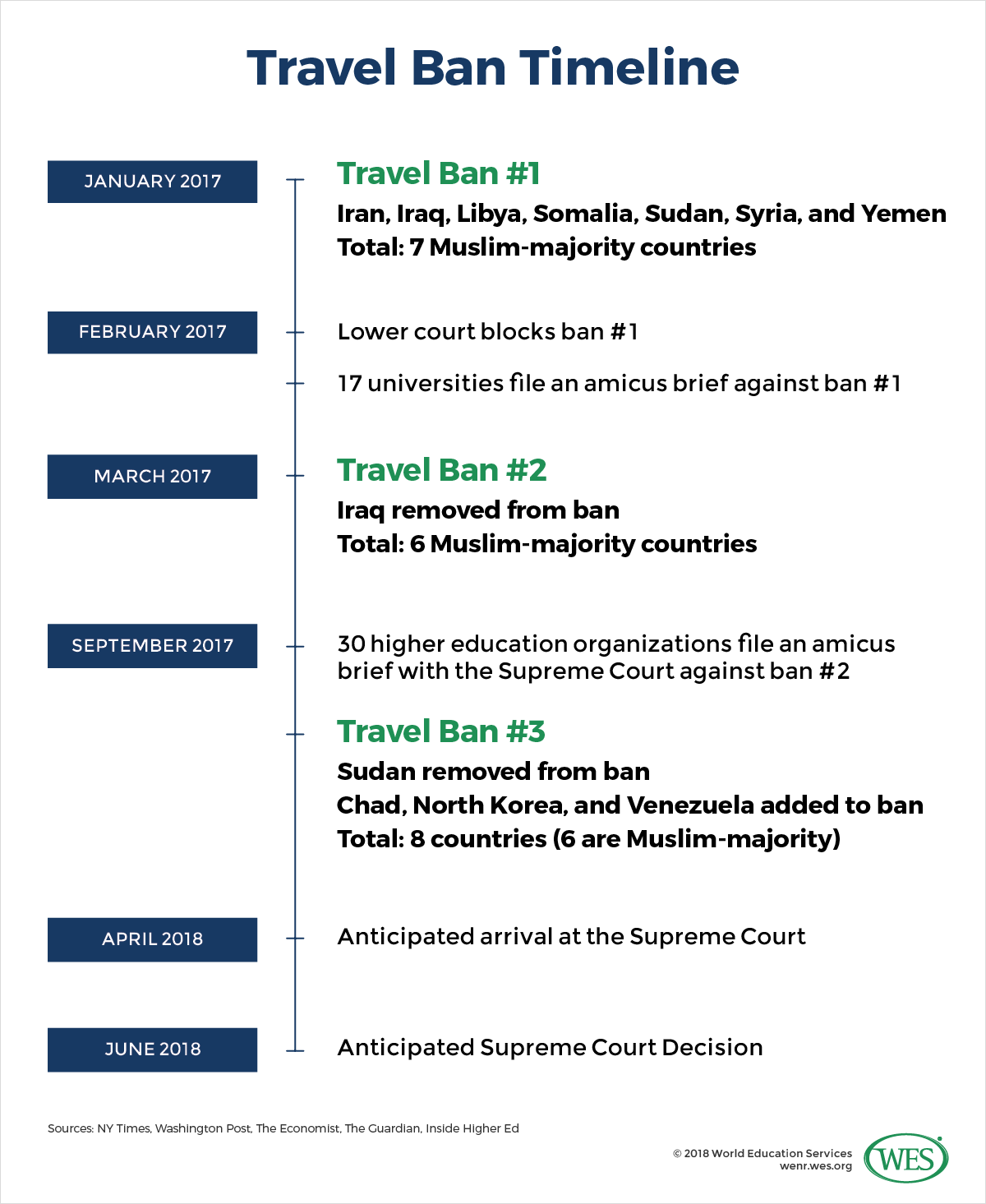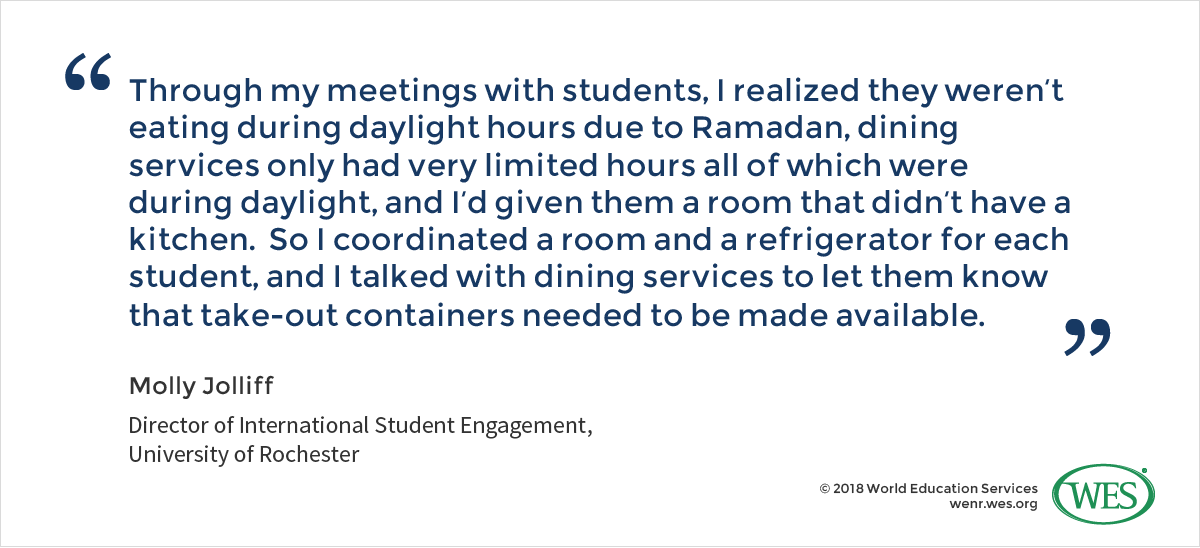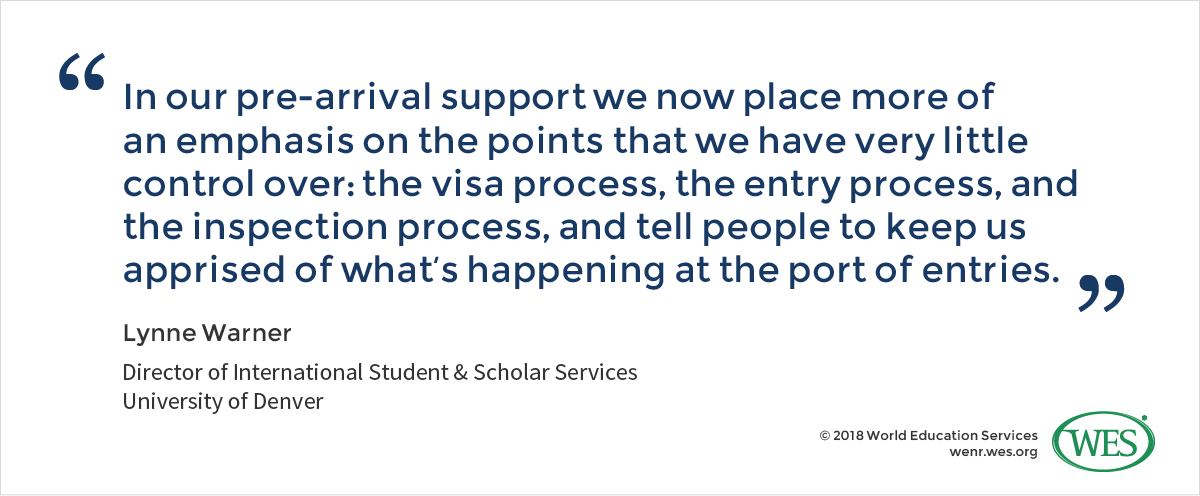Makala Skinner, Research Assistant, WES
One week after his inauguration, President Trump signed an executive order which denied U.S. entry to visa-holders from seven Muslim-majority countries. This initial “travel ban” was swiftly blocked by the lower courts [1]. Since then, the policy has undergone multiple adaptations (see Figure 1), each of which has been met with resistance from the academic community [2] as U.S. colleges and universities have marshaled together to oppose the ideas and implications of the executive order [3] through multiple avenues.
The most recent version of the ban, issued as a presidential proclamation in September 2017, expanded the restrictions to eight countries and prohibits citizens of the selected nations from traveling to the U.S. on certain visas. The ban allows individuals from all but two countries-North Korea and Syria-to enter the U.S. as students. [4] Student visa issuance, however, is contingent upon passing strenuous vetting procedures.
The travel ban and its iterations pose a mounting challenge to higher education institutions (HEIs) increasingly invested in international recruitment and campus internationalization. While the implications in terms of access to American schools is manifest, the perception that the U.S. is not a welcoming environment for international students is more difficult to reverse and cannot be adjudicated by a court. This article examines the direct and indirect impact of the travel ban on international students and provides specific steps HEIs can take to support their student body in a politically trying environment.
International Student Enrollment Trends
Many institutions have already begun witnessing negative ripple effects of the travel ban and changes to student perceptions of U.S. schools. IIE’s Fall 2017 snapshot survey found that new international student enrollment at U.S. HEIs fell 6.9 percent from the previous year [6]. The decline in enrollment will have negative financial consequences for institutions increasingly reliant on international students, who typically pay more money to attend universities and colleges than their domestic peers. Lower matriculation rates are likely to adversely impact the USD $39 billion in revenue that international students contribute to the U.S. each year. [7]
In addition to financial concerns, there is particular trepidation that fewer international students will cause the U.S. to fall behind in technological and scientific advancement. At the graduate level, international students make up a significant portion of STEM majors. Upwards of 40 percent of graduate students at MIT are international students [8], and in 2015, more than half of all U.S. doctorate degrees in engineering and math-related fields were awarded to foreign students. Consequently, enrollment is falling more swiftly in STEM than it is in other fields. [9] While there was a 4.6 percent decrease in total international student enrollment at the graduate level in non-STEM disciplines, there was a 6 percent drop in science and engineering related programs.
How Can Universities and Colleges Support International Students in this Climate?
As academic institutions grapple with the effect of the executive order and the current political climate on international student enrollment, it is imperative that schools provide targeted support to students not only hailing directly from travel ban countries, but to the larger community of international students who worry that the shifting tenor of the U.S. will negatively impact their education, career, and safety. Universities and colleges are well positioned to impact their current and future international students by helping them navigate the present political landscape, and many institutions have already taken steps to do so. Here are nine actions HEIs can take to support students affected by or concerned about the travel ban:
1. Provide One-on-One Meetings with Campus Support Offices
Offering individual consultations with campus administrators allows HEIs to gather accurate information on the challenges that international students are facing as well as discern the nuances of these dilemmas that may not readily be apparent otherwise. By correctly identifying problems, schools are able to tailor solutions to address them accordingly.1 [10] For example, Molly Jolliff, Director of International Student Engagement at the University of Rochester, met individually with students who were unable to travel home over the summer due to the risk of being denied entry back into the U.S. once school resumed. She coordinated housing and dining assistance as well as connected students with internships and summer employment opportunities. Through one-on-one conversations, Jolliff perceived that many students had planned to travel home to celebrate Ramadan but were now stranded in the U.S. Jolliff addressed the students’ specific needs and coordinated with housing and dining services to ensure that students had meal options after daylight. She also spoke with the campus chapel, which helped match students to services offered by the local Islamic center. The center paired students with host families so that they were able to connect off campus.
2. Offer Pro-Bono Legal Consultations with Immigration Attorneys
Supplying students with the opportunity to meet with immigration attorneys via group sessions or private consults ensures that students get accurate information and legal advice pertaining to their specific situation.2 [12], 3 [13] Attorneys can advise on the latest visa processing information, OPT (Optional Practical Training), and CPT (Curricular Practical Training) among other things. The University of Denver provided free access to these resources not just for international students, but for DACA students as well. Tulane University is also addressing this need and recently hired an immigration attorney to advise international and DACA students, faculty, and staff [14], on immigration issues and provide representation referrals as needed.
3. Share Travel Ban Information Through Multiple Platforms
Widely disseminating new information pertaining to the travel ban helps clarify implications of ban developments and the extent to which international students will be affected. Schools have distributed information to students by sending email summaries of the ban’s ramifications, posting information on school websites, and writing public letters stating the school’s stance on the proclamation.4 [15] requent communication on this topic helps to reassure not only students, but their families as well. At Temple University, the president wrote a letter articulating the school’s support of international students. Students forwarded the president’s letter to their parents abroad to help allay fears and offer reassurance that they have a supportive environment.
4. Supply a Designated Group Space to Address Questions and Concerns
Providing spaces for students to gather and discuss travel ban developments shows students that the institution is aware of and cares about the situation, allows for international and domestic students, staff, and faculty to come together in solidarity, and provides the opportunity for international students to connect with others facing similar situations. Schools have been supplying these spaces in a variety of forms including town hall meetings, forums, open-houses, or teach-ins. Be prepared to answer student questions and concerns to the greatest extent possible, while also noting the lack of concrete regulations put in place by the administration. Students may ask what ban developments mean for completing their degree, if it will affect their search for employment upon graduation, what the repercussions of traveling might be, and if there are visa renewal implications.
5. Consult with Experts to Ensure Accurate Information
Consistent communication, and in particular, communicating accurate information is vital while the internet flurries with misinformation and half-interpretations of the ban’s ramifications. To provide students with correct information pertaining to the executive order, administrators at the University of Rochester read the full text of the proclamation and consulted with outside attorneys to decipher its exact effect on international students. After doing so, they determined that the order is not meant to apply to students who are already in the U.S. with a visa, which is pertinent information not often noted by news outlets.
6. Provide Comprehensive Pre-Arrival Support
Providing pre-arrival support to new international students helps them navigate the strenuous visa vetting process and arms them with information on what to anticipate. The University of Denver enhanced its pre-arrival support after the ban to share with students specifics on how to prepare prior to coming to the U.S. In particular, it focused on what to expect in the new political environment, including the possibility of customs and border officers looking at social media on phones and laptops as part of the process to determine students’ eligibility to enter the U.S.
7. Leverage Social Media to Welcome International Students
Utilizing social media to share welcoming messages helps show international students that they are valued within American HEIs and helps to combat negative rhetoric. Since the first iteration of the ban student and administrative voices reverberating across the web have been gathering momentum under the #YouAreWelcomeHere initiative, created by Study Group and propelled into a national campaign by Jessica Sandberg at Temple University. #YouAreWelcomeHere [19] is a social media initiative comprised of photos, videos, tweets, and events aiming to let international students know that they are welcome at U.S. universities and colleges. To date, 335+ HEIs have joined the initiative.
8. Orchestrate Events to Increase Visibility
Planning events, either directly related to the ban or to celebrate and support international students, helps to raise the international student profile as well as visibly assert a school’s priorities. The University of Kansas, for example, had a march down the main street of campus after the presidential election in which administrators were highly visible in a show of support for international students. This spring, Temple University is holding a #YouAreWelcomeHere Week that will comprise a series of events including writing messages to incoming students, an international alumni panel and networking night, a Chinese tea ceremony, and a Global Gala.5 [21]
9. Create Volunteer Programs Relevant to Student Needs
Establishing volunteer opportunities for international and domestic students alike helps channel student energy and creatively address challenges. Schools should tailor volunteer programs to the specific needs and resources of their institutions. The University of Kansas, for example, received reports of international students facing verbal and physical harassment after the presidential election resulting in some students fearing walking to class. In response, the school put together a volunteer program for people to escort them to and from their courses.
While HEIs face different challenges depending on their location, size, or means, all schools can find creative ways to support their current and incoming international students. Providing intentional and ongoing outreach to students affected by the travel ban helps mitigate the negative consequences of the executive order as students and schools alike await the legal outcome of the ban’s third iteration. The order, likely to arrive at the Supreme Court this month, is projected to arrive at a decision by June.
1. [23] Interview, Cary Jensen & Molly Jolliff
2. [24] Interview, Lynne Warner
3. [25] Interview, Jessica Sandberg
4. [26] Interview, Charles Olcese
5. [27] Email, Leah Hetzell



![A quote from Charles Olcese, the director of international student services at the University of Kansas, who says: "You've got to be fairly vocal and fairly consistent with being vocal. Consistent communication sends a message to the students that we are concerned, that we are watching out for them and that [the executive order] is an issue that we are dealing with as a campus."](https://wenr.wes.org/wp-content/uploads/2018/04/Apr18_SkinnerQuotes-2.png)
![A quote from Cary Jensen, the senior counsel and director of international services office at the University of Rochester, who says: "I was surprised to learn that most of our current students are not within the scope of the travel ban because this was not explained in any of the news coverage. Frankly, I'm not sure that people would be willing to take the risk [of traveling] regardless. Even so, as an attorney who likes to be precise, it's been a little unsettling that there has been so much misinformation and misunderstanding on something that is so important."](https://wenr.wes.org/wp-content/uploads/2018/04/Apr18_SkinnerQuotes-3.png)

![A quote from Jessica Sandberg, the director of international admissions at Temple University, who says: "I think a silver-lining of [the ban] is that it gave us renewed energy and passion to work harder and ensure that our international students - the ones who are here and the ones who are not yet here - feel supported and understand why they are valuable to us."](https://wenr.wes.org/wp-content/uploads/2018/04/Apr18_SkinnerQuotes-5.png)
![A quote from Charles Olcese, the director of international student services at the University of Kansas, who says: "I think we announced [the volunteer] program on a Thursday, and by Monday we had about 700 people signed up. We had a lot of people coming out of the woodwork and saying, 'I am going to do this. I'm going to walk with them. I'm going to make sure [international students] feel welcomed."](https://wenr.wes.org/wp-content/uploads/2018/04/Apr18_SkinnerQuotes-6.png)